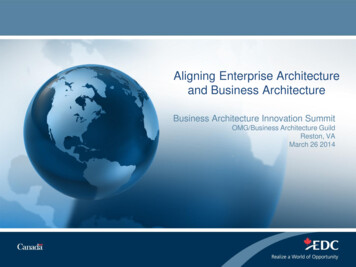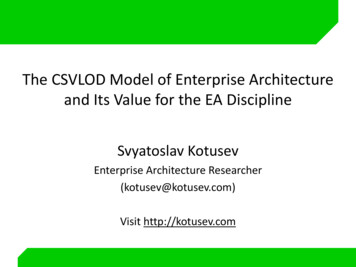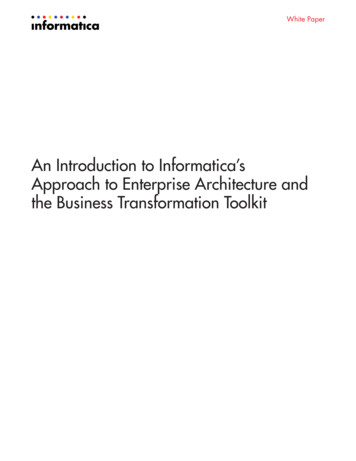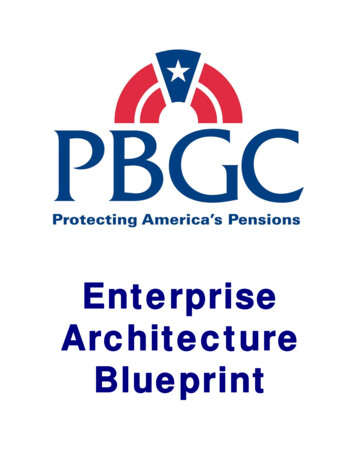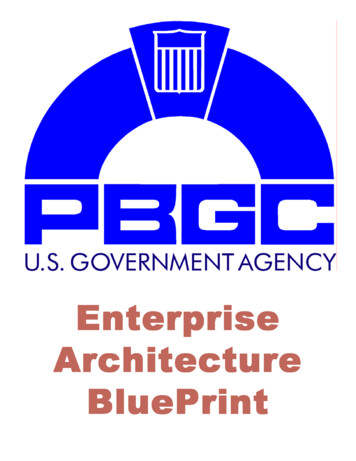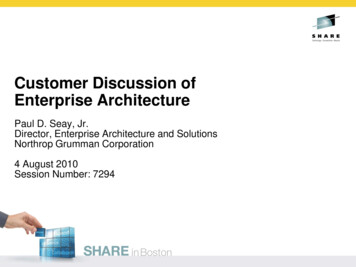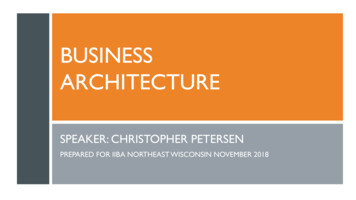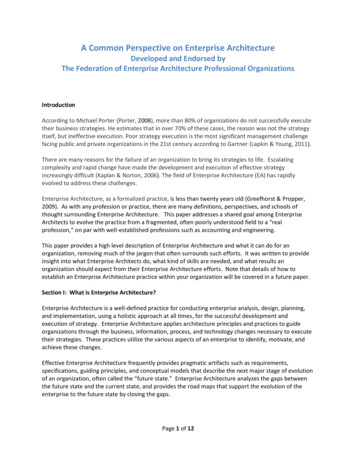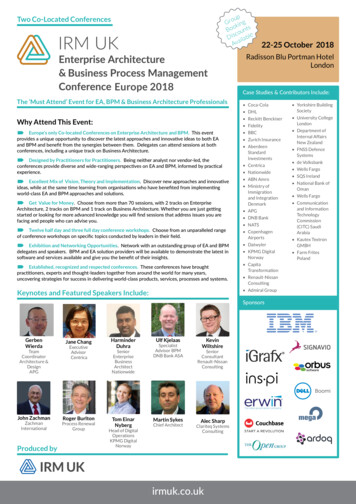
Transcription
oupGr kingoBo ountsciD s ilableAvaTwo Co-Located Conferences22-25 October 2018Radisson Blu Portman HotelLondonEurope 2018Case Studies & Contributors Include:The ‘Must Attend’ Event for EA, BPM & Business Architecture Professionals Coca-Cola DHL Reckitt BenckiserWhy Attend This Event: Fidelity Europe’s only Co-located Conferences on Enterprise Architecture and BPM. This eventprovides a unique opportunity to discover the latest approaches and innovative ideas to both EAand BPM and benefit from the synergies between them. Delegates can attend sessions at bothconferences, including a unique track on Business Architecture. Designed by Practitioners for Practitioners. Being neither analyst nor vendor-led, theconferences provide diverse and wide-ranging perspectives on EA and BPM, informed by practicalexperience. Excellent Mix of Vision, Theory and Implementation. Discover new approaches and innovativeideas, while at the same time learning from organisations who have benefited from implementingworld-class EA and BPM approaches and solutions. Get Value for Money. Choose from more than 70 sessions, with 2 tracks on EnterpriseArchitecture, 2 tracks on BPM and 1 track on Business Architecture. Whether you are just gettingstarted or looking for more advanced knowledge you will find sessions that address issues you arefacing and people who can advise you. Twelve half day and three full day conference workshops. Choose from an unparalleled rangeof conference workshops on specific topics conducted by leaders in their field. BBC Zurich Insurance AberdeenStandardInvestments Centrica Nationwide ABN Amro Ministry ofImmigrationand IntegrationDenmark APG DNB Bank NATS CopenhagenAirports Yorkshire BuildingSociety University CollegeLondon Department ofInternal AffairsNew Zealand FNSS DefenceSystems de Volksbank Wells Fargo SQS Ireland National Bank ofOman Wells Fargo Communicationand InformationTechnologyCommission(CITC) SaudiArabiaExhibition and Networking Opportunities. Network with an outstanding group of EA and BPMdelegates and speakers. BPM and EA solution providers will be available to demonstrate the latest insoftware and services available and give you the benefit of their insights. Datwyler Kautex TextronGMBH KPMG DigitalNorway Farm FritesPoland Established, recognized and respected conferences. These conferences have broughtpractitioners, experts and thought-leaders together from around the world for many years,uncovering strategies for success in delivering world-class products, services, processes and systems. CapitaTransformationKeynotes and Featured Speakers Include: Admiral Group ordinatorArchitecture &DesignAPGJohn ZachmanZachmanInternationalProduced byJane ChangExecutiveAdvisorCentricaRoger BurltonProcess ArchitectNationwideTom EinarNybergHead of DigitalOperationsKPMG DigitalNorwayUlf KjelaasSpecialistAdvisor BPMDNB Bank ASAMartin SykesChief sanConsultingAlec SharpClariteq SystemsConsultingirmuk.co.uk
Keynotesirmuk.co.ukEnterprise Architecture KeynotesArchitecture in an Age of AgilePlenary KeynotesThe Value of Management is theManagement of ValueGerben WierdaTeam Coordinator Architecture & DesignAPGAgile approaches to business transformation have swept the world. More and moreorganisations look at agile methods such as SAFe or approaches such as DevOps to manage theirtransformation. Agile methods are a reaction to the failure of waterfall approaches to consistentlydeliver results. Waterfall requires predictability, a commodity that is becoming more scarce overtime. Agile promises a better way to get results in a constantly changing world. Where does thatleave architecture? The agile manifesto claims that architecture ‘emerges’ from well functioningteams, but this has proven to be naive and there are good reasons why this is so. So if goodarchitecture doesn’t emerge automatically, how can we get good architecture in an agile setting?The answer lies in freeing outselves from certain assumptions about both architecture and agile. Good architecture does not automatically emerge in agile settings Classic architecture approaches are often in conflict with agile transformation Certain practical choices can help solving the conundrumBack to Art School: Design is the Future of Enterprise ArchitectureMilan GuentherPartnerEnterprise Design AssociatesIn March 2017, Gartner* said: “By 2018, 40% of enterprise architects will focus on design-drivenarchitecture, “ and then went on to talk about the creative superpowers of Design Thinking. Fastforward to October 2018. Are you design-driven yet? And no, this is not about running anotherDesign Thinking workshop. Looking into 10 years of “Design Practice” experience applied tocomplex environments, Milan will show you how to use Design to give shape to enterprises.Applied in a holistic and systemic fashion, Design can help us deal with challenges of innovationand transformation. It can act as the glue between Customer Experience and EnterpriseArchitecture, and tackle the complexity that makes ambitious endeavours so ambitious - andworthy of our artistic attention.* Smarter with Gartner: The evolution of Enterprise Architecture ution-of-enterprisearchitectureRoger BurltonPresidentProcess Renewal GroupBusinesses are undergoing tumultuous changes. Is your organization ready for the move toa new way of working? Are you? End to endvalue chain optimization and unrelenting valuemanagement will be critical. Effective crossfunctional operations and shared motivationto deliver value will have to become the norm.‘Management’ will become a required disciplinefor all knowledge workers to be able to createvalue. Organizations will look for a positivereturn on their investment in management justthe way it viewed return on capital – or themeans of production – in industrial times. Withcontinuous flowing business change becomingthe norm, internal transformation will be aconstant requirement for sustaining businessrelevance in the marketplace. An unrelentingfocus on value will just become normal. This isyour future. Will you help make it happen? Ages and Revolutions – lessons learned Adam KlasaCEOFarm Frites PolandFarm Frites Poland (FFP) is a major producer of french fries for McDonalds and other foodretailers in Europe. The company has been developing its integrated management system (FSSC22000, OHSAS 18000, ISO 14000, etc.) for many years whereby the concept of implementingthe process management approach has been evolving for some time. Recently, it decidedto implement the full version of process management. They realized that the approach toimplementation and actions behind this must be adapted to the organizational culture so thatemployees can understand the change and become involved in the process. The main objectiveof the implementation was to increase the effectiveness of cooperation between the companydepartments and between the plant and the FFP farm supplying the raw material. Theimplementation of process management started by identifying processes and their ‘processarchitecture’. In March 2017, they launched a pilot testing of management of two processesselected from the processes defined in the architecture.Self-Management and the Process Centric OrganisationSasha AganovaSenior ConsultantProcess Renewal GroupWhat this means for analysts, architects anddesignersWhy after twenty years doing a role does everyday still seem full of obstacles? Surely by now Ishould have worked out how to do it? But thenI remember I’m an Architect, and the job is allabout dealing with the obstacles, both large andsmall, so the organization can move forward. Ina series of short lessons from my experience,set in the stoic philosophy of Marcus Aurelius,we will explore the means to challenge thoseobstacles by: Imagine a company with no bosses and no time or money wasted on complex layers of management. This is a reality today for a growing number of organizations that are adopting self-management structure. These organizations achieve true organizational agility and eliminateunnecessary management overhead activities. While the self-management organization come indifferent shapes and sizes, there is one common aspect between all of them, and that is a focus onprocess management. In fact, an end to end process view becomes the common language that thevarious teams use to communicate, and operate on a daily basis. In this session Sasha will:Altering your perspective to find newoptionsWhat’s right is what works, but does the endjustify the means?Failing cheaply and quickly, there’s nothingwrong with being wrong so long as you don’tdelay the important projectsUsing the flank attack, because rarely willthe direct assault be successfulFocus on something bigger than yourself tobring everyone with you for EA – choosingthe most relevant EA proposition, scope, andinterventions; mastering uncertainty; andworking with business leadersGroup Booking DiscountsDiscuss how self-management enables a highly scalable and agile enterpriseLearn the essence of end to end value process management as can be applied in anyorganization Understand how some self-managed organizations operate Develop an appreciation for how process management is critical for self-managed organizations2Value and business agilityMartin SykesChief ArchitectA Business Process Management Journey Value orientation – the value chain, valuestreams and workThe Obstacle is the PathBPM Keynotes Who cares about valueirmuk.co.uk2-3 Delegates4-5 Delegates6 Delegates10%20%25%
AgendaMonday 22 October 2018: Pre-Conference WorkshopsMorning Workshop - 09:30 - 12:45Getting Started in EA:Designing an Architecture Function to Fit yourEnterpriseSally Bean & Philip HellyerManaging Complexity andChangeJohn Zachman, ZachmanInternationalFirst Do It, Then Do ItRight, Then Do It BetterMartin Sykes, ChiefArchitectA Foundation for ProcessPerformance ImprovementSasha Aganova, ProcessRenewal GroupThree Key Techniques forBusiness DesignRonald G. Ross, BusinessRule SolutionsIntegrating Change Into YourBusiness Process Approach– Timing Is EverythingAlec Sharp, Clariteq SystemsConsultingOrganizational Architecture & Design for DigitalDexterityJohn Gøtze, QualiWareBusiness ArchitectureEssentialsRoger Burlton, ProcessRenewal GroupIntelligent AutomationAssessmentTom Einar Nyberg, Head ofDigital Operations, KPMGDigital - NorwayGet The Circles Turning:Innovating Process-basedManagementRoger Tregear, LeonardoConsultingAfternoon Workshop - 14:00 - 17:15Behavioural Approachesto Building Effective Architecture TeamsSally Bean & Philip HellyerEvaluating Architectures:A Hands-on Introduction tothe Solution ArchitectureReview MethodDr Simon Field, EnterpriseArchitect, Admiral GroupTuesday 23 October 2018: Conference Day 1 & Exhibits08:00 - 09:00Registration09:00 - 09:15Conference Welcome: Roger Burlton, President, Process Renewal Group & Martin Sykes, Chief Architect09:15 - 10:15Plenary Keynote: The Value of Management is the Management of Value, Roger Burlton, President, Process Renewal Group10:45 - 11:35Applying Behavioral Insightsto EA PracticeNiels Terkelsen, EnterpriseArchitect, Ministry ofImmigration and Integration,DenmarkMaking Models Make SenseSteve Whitla, Visual MeaningLtdPutting Strategy on Technology Wheels with BusinessArchitectureMayank Saxena, EnterpriseArchitect (Chief Architect& Data Management), ABNAMROA Holistic Approach to GDPRUsing BPMSSimone Novali, EnterpriseArchitect, Zurich Insurance &Simone Cella, NTT DATA ItalyTaking Value Streams Underground: Moving from Corporate Visions to OperationalProcessesSteve Hutchings, BusinessAlignment Lead, CambridgeAssessment11:40 - 12:30Enterprise ArchitecturePracticeAli Hassaan, Senior EnterpriseArchitect, National Bank ofOmanLessons from the CyberFront LineKevin Hall, Senior Director,Alvarez & MarsalThriving EnterpriseArchitectureEswar Ganesan, Head EnterpriseIntegration, Netherlands BasedMultinationalProcess Center of Excellence(PCoE), Key Initiative inAchieving Process MaturityUlf Kjelaas, Specialist AdvisorBPM, DNB Bank ASAData Quality: So Much MoreThan You ThinkRonald G. Ross, Business RuleSolutions12:30 - 14:00Lunch, Exhibits & Perspective Sessions13:00 - 13:25Perspective Session: Implementing our EA Tool – How Being Quick and Connectedis Paying Off Kevin Jackson-Barnes, Business Architect, Aberdeen Standard InvestmentsPerspective Session: DHL Supply Chain: A Process Journey (Develop, Proliferate &Standardise) Tim Bolam, VP IT Project Delivery & Business Development, DHL Supply Chain13:30 - 13:55Perspective Session - The BBCs Journey to Standardisation through CollaborationSarah Bullen, Head of Business Analysis, BBC Design & EngineeringPerspective Session - Enterprise Architecture and Portfolio Management Insights,Russel Jones, Consultant, Orbus Software14:00 - 14:50Enterprise Architecture Keynote: Architecture in an Age of Agile, GerbenWierda, Team Coordinator Architecture & Design, APGBPM Keynote: A Business Process Management Journey, Adam Klasa, CEO,Farm Frites Poland14:55 - 15:45How an IT ApplicationLandscape Enables ImportantBusiness Outcomes at Copenhagen AirportsJacob Behrend, IT StrategyManager, Copenhagen Airports &Uffe Donslund, Strand & DonslundAvoiding UnintendedConsequences of ChangeJohn Zachman, ZachmanInternationalBusiness Architecture Panel:Business Architecure and theA3 Organization: Automation,Analytics & AIDecoding your RPA JourneyMelanie Byrne, Senior Manager- Head of Business AnalysisIreland, SQSThe T-Shaped Professional: Achieving Process andArchitecture Goals by OtherMeansAlec Sharp, Clariteq SystemsConsulting16:15 - 17:15Business Transformationthrough Practical EnterpriseArchitectureAnil Kalbag, DistinguishedEngineer IT, Cisco SystemsDigital Government of theFutureRegine Deleu, All of Government Enterprise Architect,Department of Internal AffairsNew ZealandLeveraging Business Architecture for Innovation & Success:A Business Analyst and Business Owner PerspectiveDebra Paul & Jonathan Hunsley,AssistKDHow to Handle a MassiveChangePinar Bakal & Zeynep Ozturk,FNSS Defence Systems“No. What is the CustomerPerspective?” A BusinessProcess Focused ApproachSophie Anne Jones, BusinessAnalyst, UCL17:15 - 18:30Drinks Reception & ExhibitsEnterprise ArchitectureBusiness ArchitectureTom Einar Nyberg, KPMG Digital,Michael Noonan, Capita Transformation, Joanna Goodrick, MikeRosenBusiness Process ManagementWednesday 24 October 2018: Conference Day 2 & Exhibits09:00 - 10:00Plenary Keynote: The Obstacle is the Path, Martin Sykes, Chief Architect10:05 - 10:55Architecting for a Digital Futurein Financial ServicesTim Pryke, Lead EnterpriseArchitect, Yorkshire BuildingSocietySecurity by DesignJane Chang, ExecutiveAdvisor, CentricaAgile Business ArchitectureEnabling Agility of Business &Agility of ITAlex Romanov, AvrolabsCustomer Oriented ProcessManagementPieter Jongstra, Manager BPMand Lean, de VolksbankHigh Speed OrganisationsPeter Matthijssen, ChiefTechnology Officer, BiZZdesign11:25 - 12:15Architecture in 2018: Speed,Scale, Scope, Change,AutonomyMike Rosen, Wilton ConsultingGroupHow Can Enterprise Architec- Business ArchitectureInfluenced Investment Planningture Easily Save The World?Roger Evernden, evernden.net Harminder Duhra, SeniorEnterprise Business Architect,NationwideInnovative Process Managementin the Kingdom of Saudi ArabiaDelivering Customer Value:Finding the Real Needs of yourCustomers Beyond Wish ListsJon Jenkins, Kautex Textron &Ben Alexander, PMG.net12:15 - 13:45Naif Sheshah, Communicationand Information TechnologyCommission (CITC)Lunch, Exhibits & Perspective Sessions12:45 - 13:10Perspective Session - Digital Innovation and Connected Experiences, Mark Watts, Dell BoomiPerspective Session - MEGA13:15 - 13:40Perspective Session - Making Business Transformation a Success: A Case Studywith Fidelity, Olivier Kouao, Operational Architecture, Fidelity InternationalPerspective Session - Old EA is Dying. What’s Next?, Petteri Vainikka, CMO, Ardoq13:45 - 14:35Enterprise Architectue Keynote: Back to Art School: Design is the Future ofEnterprise Architecture, Milan Guenther, Partner, Enterprise Design AssociatesBPM Keynote: Self-Management and the Process Centric OrganisationSasha Aganova, Senior Consultant, Process Renewal Group14:40 - 15:30An Introduction to the TOGAFStandard, Version 9.2Mike Lambert, Fellow of TheOpen GroupAir Traffic Management Architecture – Bringing Clarityfrom ComplexityKatie Duffy, Enterprise Architect, NATSBridging Business Strategy toExecutionBao Do, Enterprise BusinessArchitect, Wells Fargo16:00 - 16:50From Project Funnels to ProductLifecycles : a Capability-basedView of the Organisation inPractice , Joanna Goodrick,Cambridge AssessmentMega-banks Architecture asa NetworkAndra Sonea, Consultant &ArchitectEnterprise ArchitectureManagement for Smart CitiesZohreh Pourzolfaghar & Markus Helfert, Senior Lecturer,Dublin City University16:55 - 17:10Conference Close: Martin Sykes, Chief Architect & Roger Burlton, Process Renewal GroupPanel Discussion: What’s Nextfor BPM? Insights from theFront LinesRoger Tregear, LeonardoConsulting, Alexandra Kokkonen,RB Group, Naif Sheshah, CITC,Sabrina Gérard, Datwyler SealingSolutions, Katy Murarotto, CocaCola European PartnersThe BPM MythbustersRoger Burlton, ProcessRenewal Group & Alec Sharp,Clariteq Systems ConsultingDeveloping Processes whichCreate Customer Value - anIndustry-wide PerspectiveKevin Wiltshire, Senior Consultant, Renault-Nissan ConsultingThursday 25 October 2018: Post-Conference Workshops - Full Day Workshops - 09:00 - 16:30Achieving Business Agility and the Business Agility ManifestoRoger Burlton, Ronald G. Ross and John ZachmanArchitecting the Digital Business PlatformMike Rosen, Wilton Consulting Groupirmuk.co.ukRunning Enterprise Design Sprints Using A Milky WayMap, Milan Guenther, Enterprise Design Associates &Annika Klyver, IRM Sweden3
Pre - Conference Workshops Monday, 22 October 2018Half Day Workshops:Getting Started in EA: Designing anArchitecture Function to Fit yourEnterpriseSally Bean, Enterprise Architecture Consultant,Sally Bean Ltd & Philip Hellyer, EA Consultant,Philip & FinchThis workshop is for anyone who wants tounderstand EA better or who wants to establish EAin their enterprise. We will look at how differentorganisations approach EA, what effective architectsproduce, what pitfalls people encounter, and wherethe value comes from. Using some of our favouredtechniques, we will help you to think about how youmight design an EA function in your organisation thatdelivers value alongside other disciplines and types ofarchitect. Attendees will gain foundational knowledgeabout EA to take into the rest of the conference. The essence of EA: an overview of methods,frameworks and techniquesHow to integrate EA with other disciplinesand how it relates to more specialised types ofarchitectureHow to apply architectural approaches to thedesign of the EA practice itselfManaging Complexity and ChangeJohn Zachman, CEO, Zachman InternationalFor 7,000 years, the only device humanity hasdiscovered for managing complexity and change isArchitecture. If the object you are trying to create isso complex that you can’t see it or understand it at thelevel of definition required to create it, you have to formalize its descriptions: Architecture. And, if you everhave to change what you have created, you must haveaccess to the Architecture you formalized to avoid theunintended consequences of changes. Even smallchanges can be cataclysmic in nature. This workshopdefines Architecture in the context of Enterprises andsuggests approaches for its definition.a simple and systematic approach for analysing,modeling and redesigning specific processes. Itprovides a solid basis for newbies and a greatrefresher for anyone experienced with process.Business managers, analysts and change practitionerswill gain from the hands on working sessions thatapply the techniques. This session establishes a soundbaseline and, a common language for all businessanalysis conference sessions you attend. Attendeeswill learn: Why do Process work? Core concepts of Business Process Architectureand Process Improvement Understanding the scope for change Analysing the current state Designing the future state Supporting implementation and ongoingsustainmentThree Key Techniques for BusinessDesignRonald G. Ross, Co-Founder and Principal,Business Rule SolutionsThese days business design must produce business capabilities that are knowledge-based, digital-ready, andservice-oriented. Achieving excellent results requiresprofessional upskilling.This tutorial discusses three innovative techniques tosuccessfully architect business capabilities: Concept models. Understand the structuraltechniques needed to build a semantically robustbusiness vocabulary. A concept model can serveas a blueprint to express and communicatebasic business knowledge at scale, as well as tointegrate siloed business functions. Question Charts. Examine operational businessdecisions from a business point of view, analyzetheir inherent structure, and capture the businesslogic needed to support them. Q-Charts canbe used to broadly rethink and fundamentallyreorganize related business processes. First Do It, Then Do It Right, ThenDo It BetterMartin Sykes, Chief ArchitectDuring the workshop we will share and evaluatethe options for developing people, processes andtechnology to support an Enterprise Architectureteam. I’ll bring the structure for the workshop andlearnings from six teams over 20 years. You bringyour experience, scenarios and a willingness to share.This workshop is targeted specifically at lead EAs,Chief Architects and Heads of Architecture practiceswho have either set-up an architecture practice ormanaged an architecture team at least once and arenow in a position where they may be about to do itagain in a different context, or are ready to make somesignificant changes to improve performance. Thisexperience is a necessary pre-requisite to activelyparticipate in the workshop.A Foundation for ProcessPerformance ImprovementSasha Aganova, Senior Consultant, ProcessRenewal GroupThis session provides the foundation for the rangeof practices of improving specific business processperformance metrics into a renewed target state. Itis based on proven formal methods and over twentyyears of practical experience of the hundreds ofprojects conducted by Process Renewal Group andthe sage advice found at the knowledge portal:BPTrends.com. It provides an overview and discussionof the principles, concepts and techniques requiredfor the process improvement. The seminar introduces4Knowledge-based value chains. Model valuechains holistically from a knowledge perspectiveto understand natural dependencies and build-upsequence. Knowledge-based value chains can beused for strategic assessment of current businesscapabilities and identify broad opportunities forre-use and integration.You’ll walk away from this tutorial with fresh insightsabout how your company can operate more effectivelyin the digital economy. It’s guaranteed to change theway you think about the make-up of your businesscapabilities!generalised change method.”This is not an accident. In 35 years of introducing organisational and process change, experimentation andadjustment has led to refinements in techniques, andin the order in which major steps are completed. Bothof these have been designed to minimise resistanceto change, and accomplish significant change in Agiletimeframes. “Minimalist” session plans will be introduced that routinely deliver significant results in justthree to five days.This session will introduce the central features of thismethodology. Key points include: The top five Business Process anti-patterns – whatNOT to do; The problem with problem statements – why youshouldn’t start with one; “What” first, “who and how” later – how“abstraction to the essence” dissipates resistance; Understanding all perspectives – the critical role ofa stakeholder-based assessment; Features, assumptions, and enablers – key tosuccessful process design/redesign.Behavioural Approaches to BuildingEffective Architecture TeamsSally Bean, Enterprise Architecture Consultant,Sally Bean Ltd & Philip Hellyer, EA Consultant,Philip & FinchEffective architects are those who can point to clearevidence of their contribution to successful change.They never walk alone, even if they’re the only architect in town. Team-working and collaboration are vitalfor high performance, regardless of whether they arejust starting an EA journey, are part of an establishedEA group, or are a lone voice in a multi-disciplinarygroup.Many architects have technical backgrounds thatcause them to neglect the vital behavioural skillsneeded to tackle increasingly complex challenges.They must influence diverse stakeholders with (oftenconflicting) ways of working, values, and priorities.These abilities are not well addressed by industry skillsframeworks and are not always amenable to standardtraining courses. In this workshop, we will look at howbehaviour choices help and hinder success, examinethe range of competencies needed to be truly effective, and explore different ways of working together. Strategies for noticing, understanding, andinfluencing behaviour. Skills for building productive working relationshipsat all levels Ways of co-designing successful outcomes for allstakeholdersLearning Objectives: Understand the pragmatic techniques needed toengineer business knowledge Explore new ways to enrich business processmodels and business architectures Enable better strategic assessment and planning ofprogram and project portfolios Ensure a sound basis for introducing new digital,RPA and NLU technologiesIntegrating Change Into YourBusiness Process Approach – TimingIs EverythingAlec Sharp, Senior Consultant, Clariteq SystemsConsultingAn emergent methodology has led to interestingobservations from clients about its impact on change.One said, “When we follow the method closely, almost slavishly, the usual resistance to change simplydoesn’t materialise.” Another said “We’re not justusing the method on business processes – we use it as airmuk.co.ukEvaluating Architectures: A Handson Introduction to the SolutionArchitecture Review MethodDr. Simon Field, Enterprise Architect, AdmiralGroup plcThis workshop introduces participants to the SolutionArchitecture Review Method, a collaborative approachto conducting risk trade-off architecture evaluations.Participants will learn how to: Identify and classify the solution stakeholders Create the context for the evaluation bydeveloping a set of scenarios that are thenclassified according to a standard quality model Conduct an analysis workshop that explores thestrengths and weaknesses of competing solutionarchitectures, analysing risk trade-offs from theperspectives of: Quality characteristics and sub-characteristics
Pre - Conference Workshops Monday, 22 October 2018 Solution stakeholder classes and individualstakeholdersScenarios Evaluate a cost-benefit analysis of the competingsolution architectures Adopt the method within their organisations in thecontext of their project and procurement life-cyclesParticipants will learn the method by applying itduring the workshop using a simple example andwill receive a copy of an Excel-based spreadsheettool so that they can apply the method in their ownorganisations.Organizational Architecture & Designfor Digital DexterityJohn Gøtze, Senior Consultant, QualiwareDigital First, Digital to the Core, Smart XYZ, how do enterprises cope with “the digital”?The real digital advantage comes from having an organization designed to adapt with dexterity along withrapidly advancing digital technologies. Digital dexterityis defined by MIT as the ability to rapidly self-organizeto deliver new value from digital technologies. Successful enterprises manage to both explore and exploit“the digital”; they become ambidextrous.In what we call Organizational Architecture & Design,we use the Extended Enterprise Architecture Cube(EA6) to understand and enable ambidextrous organizational practices in the digital enterprise. Whetherfor exploitation of the established architecture, orfor exploration of new innovations, or for both, mostenterprises need to improve their digital dexterity, andour claim is that an enterprise must use one coherentapproach in order to become ambidextrous.The proposed approach combines enterprise architecture, risk and security management, value andoutcome management, strategic enterprise design, organizational design, and more. The approach is calledEA6 because it has six core “faces”, or views, that wesee as fundamental elements. Being a cube, there arealso 8 vertices (“corners”) which we have found to beuseful viewpoints for observing and handling behavioral patterns.In this workshop, we will introduce the EA6 approach,how to use it, and look at examples/cases of its use.You will learn: What is Digital Dexterity at an enterprise level? What is Organizational Architecture & Design andhow is it related to Enterprise Architecture? What is the Extended Enterprise ArchitectureCube (EA6) and how does it relate to EA3, TOGAF,ISO420X0, etc.?Business Architecture EssentialsRoger Burlton, President, Process Renewal GroupBusiness Architecture provides a strong foundation forbusiness-wide transformation, digitization and optimization. Given the inherent complexities, making theright choices in what to change is not simple. Designing great solutions that avoid duplication and sub-optimization means that all of the moving parts must beclassified, well understood and inter-connected beforetransformation can confidently begin. Business Architecture subject areas are numerous. Processes andcapabilities and other important dom
irmuk.co.uk 3 Agenda Tuesday 23 October 2018: Conference Day 1 & Exhibits 08:00 - 09:00 Registration 09:00 - 09:15 Conference Welcome: Roger Burlton, President, Process Renewal Group & Martin Sykes, Chief Architect 09:15 - 10:15 Plenary Keynote: The Value of Management is the Management of Value, Roger Burlton, President, Process Renewal Group Enterprise File Size: 971KBPage Count: 15

